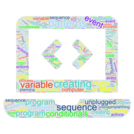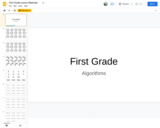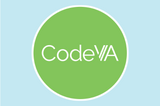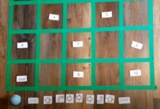
This game is played the same way you would play hopscotch.
- Subject:
- Computer Science
- Health/Physical Education
- Material Type:
- Activity/Lab
- Author:
- #GoOpenVA Administrator
- Date Added:
- 05/10/2023

This game is played the same way you would play hopscotch.

Students will construct a program to help their friend safely retrieve their stuffed animal. They will debug their program if needed. They then will observe whether there are patterns in their codes which could be looped. AS they discuss their programs, they will be encouraged to use ordinal numbers.

This is a list of basic vocabulary with definitions and/or examples that will be used in elementary classrooms K-5 when teaching the concepts of algorithms and programming.

This is a link to the printable resources to accompany the lesson Algorithms and Programming (link below).
The materials include printable coding cards and math equations for an unplugged math game. The students will work together to create algorithms in order to solve mathematical equations.
Link to Lesson Plan:
https://docs.google.com/document/d/1-eArOYRBrJnFK1Q4tt5fBvwt1wmYoCOMVd8yOWhhM-4/edit?usp=sharing

Set students up for programming success by creating a BeeBot anchor chart!These editable instructions will help students identify their role as planner or driver and set clear expectations of how Bee-Bot is used in computer programming. Tips:Introduce Bee-Bot whole classMake sure students understand the importance of the clear (x) button to erase the previous codealways press clear first to signal a new code (like how a capital letter signals the start of a new sentence) Plan the program in developmentally appropriate steps (some students program one step at a time, while others can program to the end goal)Turn the Bee-Bot off and use it as a game piece to write successful algorithmsHave students write their plan, or algorithm, on a whiteboard instead of using the cardsThe Bee-Bot emulator is perfect for guided practice!

Students will love programming their "robot teacher" to maneuver around the classroom in this introductory coding lesson. Basic computer science concepts are defined and applied as students work together to plan, create, and test algorithms. Students will recognize that programmers are the brains behind machines and technologies.

This lesson consists of two sections. First, students will explore with a Sphero Indi and document its responses to different color mats. Then, students will use the color codes to navigate their Sphero Indi to the correct letter completing four different patterns.

Patterns are hidden everywhere, and can help us read because we can predict what might happen quickly. Students will orally tell a fictional story in a sequential manner. Students will draw illustrations to match their story, and include some type of patterning (numerical, AB, cumulative story, etc).These materials were created by CodeVA in partnership with George Mason University and were funded by the National Science Foundation under Grant Award #1837380

Students will code the Sphero Indi robots to build words that match a picture based on a phonics skill. Students will need to use the color codes to figure out what each code means to drive the car over the correct letters needed to spell the words.

Students will build a program to retell a story. Students will include sequencing and debugging, abstraction, patterns, loops, and decomposition skills to effectively tell the story events and include essential story elements.These materials were created by CodeVA in partnership with George Mason University and were funded by the National Science Foundation under Grant Award #1837380

After reviewing tips for following instructions, students will use plane figures to create a mystery image using their teacher's algorithm. Unfortunately, the teacher's directions are not very precise. Students will lend a hand by giving detailed feedback to debug and clarify the set of ordered instructions to successfully build a snowman.

This video helps explain a simple unplugged algorithmic math game. Students will solve a basic addition or subtraction problem, locate the answer on a checker board or premade mat, and write an algorithm using arrow cards to get their pawn to the correct answer.
Link to Lesson:
https://goopenva.org/courses/algoithms-and-programming
Link to materials:
https://goopenva.org/courses/first-grade-lesson-materials-algorithms-and-programming